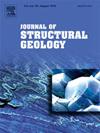大别-苏鲁造山带是否发生了沿走向的大陆俯冲样式变化?
IF 2.6
2区 地球科学
Q2 GEOSCIENCES, MULTIDISCIPLINARY
引用次数: 0
摘要
华北地块(NCB)与华南地块(SCB)的三叠纪碰撞形成了大别-苏鲁造山带,以其广泛的超高压变质岩和突出的郯庐断裂而闻名。地质和地球物理数据揭示了带内浅层和深层结构沿走向的显著差异,提出了一个关键问题:是什么构造过程驱动了这些结构变化?考虑到三叠纪碰撞涉及碰撞前的微大陆吸积和沿走向的辐合速度变化,本文采用数值模拟方法研究了微大陆宽度、辐合速率和初始莫霍温度对大陆俯冲方式的影响。该模型包含了碰撞前的微大陆增生,揭示了两阶段的俯冲演化:从单侧大陆俯冲到两侧大陆俯冲的初始过渡,随后是俯冲极性反转。高的初始莫霍温度、快速的辐合速率和广泛的微大陆增生促进了两侧俯冲的发展,其特征是初始为垂直界面,随着辐合的进行逐渐向前板块倾斜。这些俯冲样式对地壳缝合线迁移有显著影响。单侧俯冲导致水平位移最小,而双面俯冲和极性反转导致水平位移较大。在此基础上,提出了大别-苏鲁造山带在NCB-SCB碰撞过程中的演化新模式。该模型有效解释了郯庐断裂带两侧构造走向不一致、地球物理剖面高速地幔异常倾斜方向相反等沿向构造差异。此外,该模型对郯庐断裂的形成和演化也有一定的启示。本文章由计算机程序翻译,如有差异,请以英文原文为准。

Did along-strike changes in continental subduction styles occur in the Dabie-Sulu orogenic belt?
The Triassic collision between the North China Block (NCB) and the South China Block (SCB) formed the Dabie-Sulu orogenic belt, renowned for its extensive ultra-high-pressure metamorphic rocks and the prominent Tan-Lu Fault. Geological and geophysical data reveal significant along-strike differences in both shallow and deep structures within the belt, raising a critical question: What tectonic processes drive these structural variations? Considering that the Triassic collision involved pre-collisional accreted microcontinents and along-strike variations in convergence velocities, this study investigates the influence of microcontinental width, convergence rate, and initial Moho temperature on continental subduction styles using numerical modeling. The models incorporate pre-collisional accreted microcontinent(s) and reveal a two-stage subduction evolution: an initial transition from one-sided to two-sided continental subduction, followed by subduction polarity reversal. High initial Moho temperatures, rapid convergence rates, and wide accreted microcontinents promote the development of two-sided subduction, characterized by an initially vertical interface that gradually inclines towards the pro-plate as convergence progresses. These subduction styles significantly influence crustal suture migration. One-sided subduction results in minimal horizontal displacement, whereas two-sided subduction and polarity reversal lead to substantial horizontal shifts. Based on the modeling results, this study proposes a new evolutionary model for the Dabie-Sulu orogenic belt during the NCB-SCB collision. The model effectively explains along-strike structural differences, such as the inconsistent tectonic trends on either side of the Tan-Lu Fault and the opposite dipping directions of high-velocity mantle anomalies observed in geophysical profiles. Furthermore, the proposed model sheds light on the formation and evolution of the Tan-Lu Fault.
求助全文
通过发布文献求助,成功后即可免费获取论文全文。
去求助
来源期刊

Journal of Structural Geology
地学-地球科学综合
CiteScore
6.00
自引率
19.40%
发文量
192
审稿时长
15.7 weeks
期刊介绍:
The Journal of Structural Geology publishes process-oriented investigations about structural geology using appropriate combinations of analog and digital field data, seismic reflection data, satellite-derived data, geometric analysis, kinematic analysis, laboratory experiments, computer visualizations, and analogue or numerical modelling on all scales. Contributions are encouraged to draw perspectives from rheology, rock mechanics, geophysics,metamorphism, sedimentology, petroleum geology, economic geology, geodynamics, planetary geology, tectonics and neotectonics to provide a more powerful understanding of deformation processes and systems. Given the visual nature of the discipline, supplementary materials that portray the data and analysis in 3-D or quasi 3-D manners, including the use of videos, and/or graphical abstracts can significantly strengthen the impact of contributions.
 求助内容:
求助内容: 应助结果提醒方式:
应助结果提醒方式:


